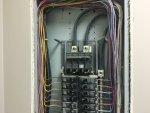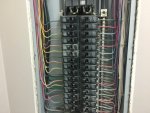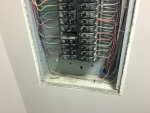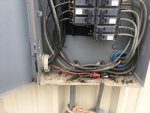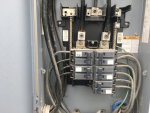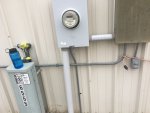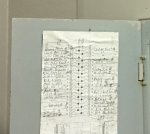CuriousHomeInspector
Member
- Location
- Little Rock, AR, USA
Okay, I have a stupid question and I'm wondering if I can't see the forest for the trees.
Split phase service (included picture of where the service conductors come into the panel and connect to the bus bars for proof). However, the non-grounded conductors go down in groups of 3. Each group of three shares a neutral. If this was 3-phase and these were separate phases, I wouldn't think this is a problem. However, as you can see from the connections to the bus bar that this is split phase... So two of the non-grounded conductors (odd numbers apart) will be connected to the same bus bar, thus the same phase angle etc, thus the neutral load would be additive, no?
So wouldn't this create more potential neutral load than the conductors are designed for? 12 AWG copper on 20 amp OCPD? If there is no load on breaker 2, and 15 amps on both breaker 1 and 3, wouldn't the neutral current be 30 amps?
There were also other deficiencies such as a branch circuit that was run in the same conduit as the service conductors (prior to disconnect device)... And they ran it to another panel and picked up the neutral/ground in the other panel for some crazy/stupid/unknown reason.
I just wanted to bounce this off another set of eyes because I'm afraid I can't see the forest for the trees as this is such a simple and dumb mistake to make? And also, shouldn't there be common trip bars as these would be MWBCs? So that all non-grounded conductors are tripped if any part of the circuit trips?
Split phase service (included picture of where the service conductors come into the panel and connect to the bus bars for proof). However, the non-grounded conductors go down in groups of 3. Each group of three shares a neutral. If this was 3-phase and these were separate phases, I wouldn't think this is a problem. However, as you can see from the connections to the bus bar that this is split phase... So two of the non-grounded conductors (odd numbers apart) will be connected to the same bus bar, thus the same phase angle etc, thus the neutral load would be additive, no?
So wouldn't this create more potential neutral load than the conductors are designed for? 12 AWG copper on 20 amp OCPD? If there is no load on breaker 2, and 15 amps on both breaker 1 and 3, wouldn't the neutral current be 30 amps?
There were also other deficiencies such as a branch circuit that was run in the same conduit as the service conductors (prior to disconnect device)... And they ran it to another panel and picked up the neutral/ground in the other panel for some crazy/stupid/unknown reason.
I just wanted to bounce this off another set of eyes because I'm afraid I can't see the forest for the trees as this is such a simple and dumb mistake to make? And also, shouldn't there be common trip bars as these would be MWBCs? So that all non-grounded conductors are tripped if any part of the circuit trips?


